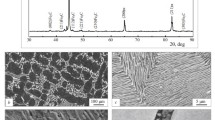Abstract
The role of cementite in the formation of the H c of carbon steels after quenching and tempering is determined based on analysis of dependences of the coercive force of У9A steel in the measurement temperature range from the temperature of liquid nitrogen to the cementite Curie point. It is shown that the key contribution to the formation of the maximum in the H c (T temp) dependence measured at room temperature is due to the magnetic hardness of cementite, whose maximum lies at T temp = 500°C. The coercive force measured at 250°C is mainly related to the interaction of the domain walls of the ferrite matrix with nonferromagnetic inclusions of cementite, the maximum of which is at T temp = 400°C, thus causing a shift of the maximum in the H c (T temp) dependence measured at the temperature above the cementite Curie point toward lower tempering temperatures.
Similar content being viewed by others
References
Mikheev, M.N. and Gorkunov, E.S., Magnitnye metody strukturnogo analiza i nerazrushayushchego kontrolya (Magnetic Methods of Structural Analysis and Nondestructuve Testing), Moscow: Nauka, 1993.
Tomilov, G.S., Mikheev, M.N., and Pomukhin, M.F., Magnetic Properties of Steels as a Basis for Magnetic Structural Analysis, Fiz. Met. Metalloved., 1959, vol. 8,issue 2, pp. 176–181.
Tomilov, G.S., Magnetic and Electric Properties of Some Structural Steels in Connection with Their Structure and Tendency to Tempering Brittleness, Fiz. Met. Metalloved., 1960, vol. 10, no. 5, pp. 681–690.
Morozova, V.M. and Mikheev, M.N., Magnetic and Electric Properties of Steels upon Different Thermal Processing, Trudy IFM AN SSSR, 1965, issue 24, pp. 3–25.
Kersten, M., Zur Theorie Der Koerzitivkraft, Zs. Physic, 1948, Bd. 124, S. 714–741.
Ul’yanov, A.I., Elsukov, E.P., Chulkina, A.A., et al., The Role of Cementite in the Formation of Magnetic Hysteresis Properties of Plastically Deformed High-Carbon Steels: I. Magnetic Properties and Structural State of Cementite, Defektoskopiya, 2006, no. 7, pp. 40–52 [Russ. J. Nondestr. Test. (Engl. Transl.), 2006, vol. 42, no. 7, pp. 452–459].
Ul’yanov, A.I., Chulkina, A.A., Gorkunov, E.S., and Zagainov, A.V., Magnetic Properties of Cementite and the Coercive Force of a Fe-5 at % C Alloy after Hardening and Tempering, Defektoskopiya, 2009, no. 5, pp. 50–59 [Russ. J. Nondestr. Test. (Engl. Transl.), 2009, no. 5, pp. 50–59].
Chulkina, A.A. and Ul’yanov, A.I., The Effect of Magnetic Properties of Cementite on the Coercive Force of High-Carbon Steels after Quenching and Tempering, Fiz. Met. Metalloved., 2009, vol. 108, no. 6, pp. 581–588.
Arzhnikov, A.K. and Dobysheva, L.V., Demangeat C. Structural Peculiarity of Cementite and Their Influence on Magnetic Characteristics, J. Phys.: Cond. Matt., 2007, vol. 19, pp. 196–214.
Gulyaev, A.P., Metallovedenie (Physical Metallurgy), Moscow: Metallurgiya, 1986.
Kondorskii, E.I., The Problem of Coercive Force of Steels, Dokl. Akad. Nauk SSSR, 1948, vol. 63, no. 5, pp. 507–510.
Mikheev, M.N. and Tomilov, G.S., The Problem of Anomalous Behavior of Coercive Force in Quenches and High-Tempered Steels, Fiz. Met. Metalloved., 1959, vol. 8,issue 3, pp. 346–348.
Chulkina, A.A., Ul’yanov, A.I., and Gorkunov, E.S., The Role of Cementite in the Formation of Magnetic Hysteresis Properties of Plastically Deformed High-Carbon Steels: III. Magnetic Properties of Patented Wire Made of Steel 25, Defektoskopiya, 2009, no. 5, pp. 50–59 [Russ. J. Nondestr. Test. (Engl. Transl.), 2008, vol. 44, no. 5, pp. 309–317].
Author information
Authors and Affiliations
Corresponding author
Additional information
Original Russian Text © A.I. Ul’anov, A.A. Chulkina, E.S. Gorkunov, 2010, published in Defektoskopiya, 2010, Vol. 46, No. 9, pp. 3–9.
Rights and permissions
About this article
Cite this article
Ul’anov, A.I., Chulkina, A.A. & Gorkunov, E.S. The effect of tempering temperature on the coercive force of high-carbon steels measured at room temperature and a temperature above the curie point of cementite. Russ J Nondestruct Test 46, 627–631 (2010). https://doi.org/10.1134/S1061830910090019
Received:
Published:
Issue Date:
DOI: https://doi.org/10.1134/S1061830910090019




